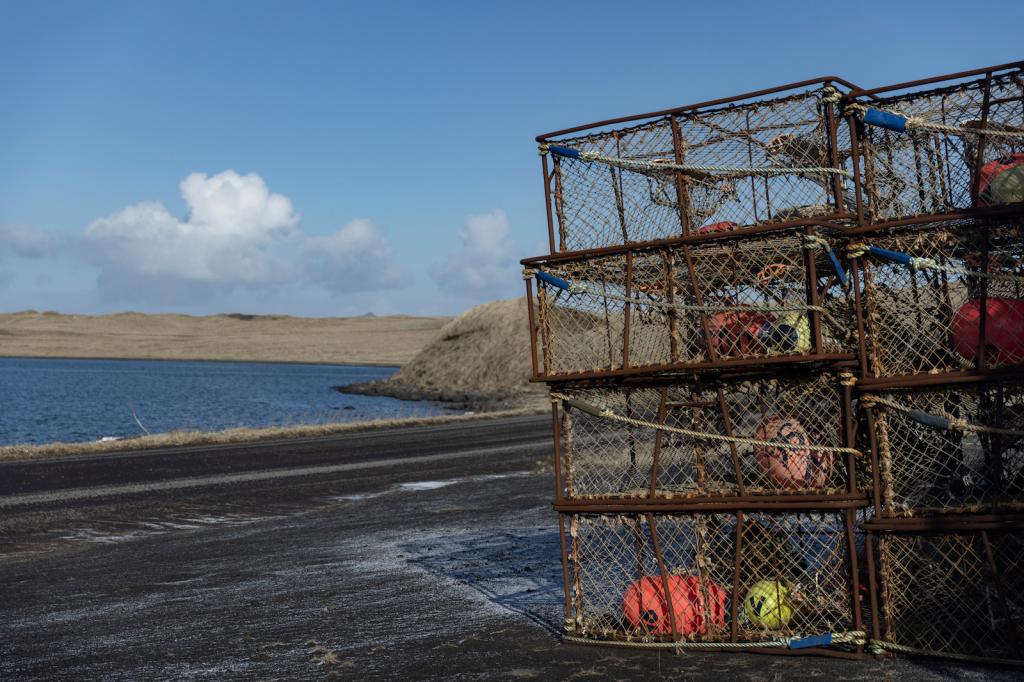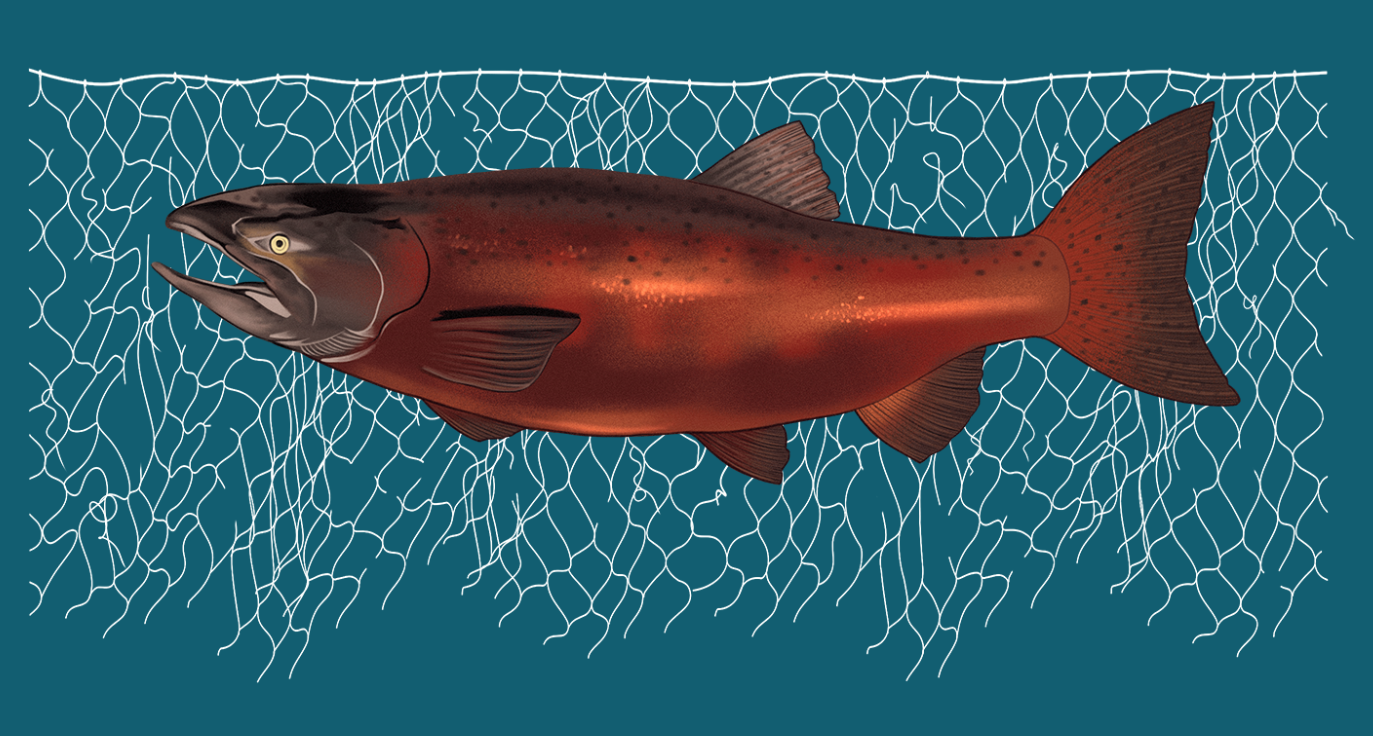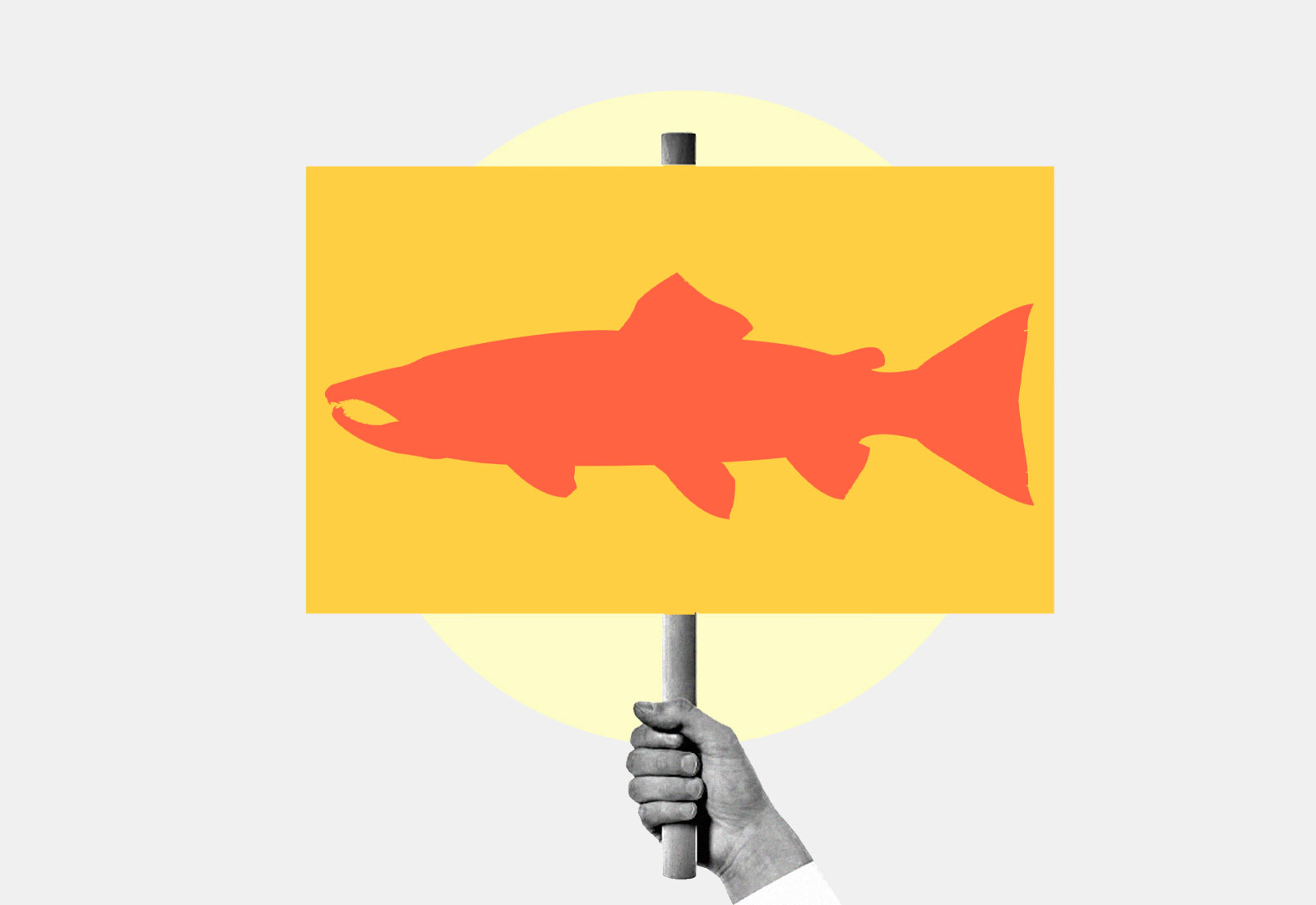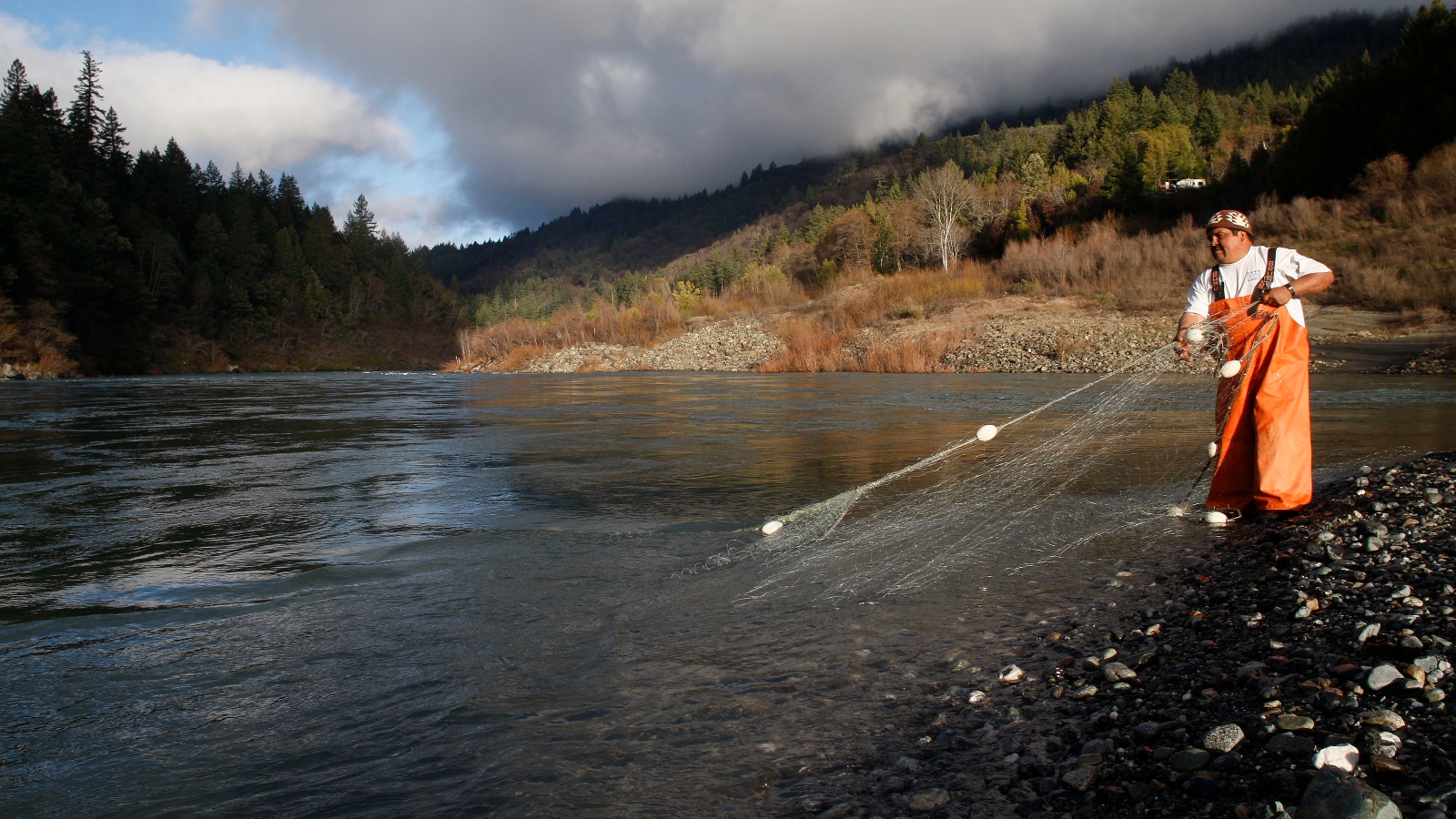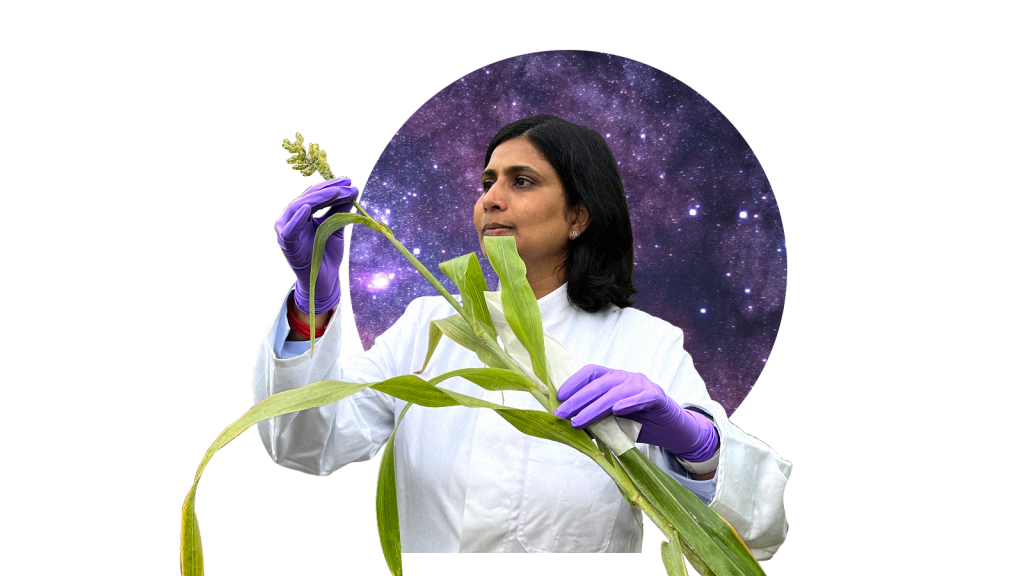Serena Fitka sat in the cabin of a flat-bottomed aluminum boat as it sped down the Yukon River in western Alaska, recalling how the river once ran thick with salmon. Each summer, in the Yup’ik village of St. Mary’s where Fitka grew up, she and her family fished for days on end. They’d catch enough salmon to last through winter, enough to share with cousins, aunts, uncles, and elders who couldn’t fish for themselves.
“We’d get what we need, and be done,” Fitka said, raising her voice above the whir of the outboard motor and the waves beating against the hull. “But now there’s nothing.”
The boat skirted the river bank as Fitka glanced out the window, her face shielded from the mid-July sun. Gray water, thick with glacial silt, lapped against the land’s muddy edge below a summer palette of green: dark spruce needles, light birch leaves, and willows a shade in between. A bald eagle soared 10 feet above the river, scanning the water.
“I thought this wouldn’t happen in my lifetime,” Fitka said. “I thought there would always be fish in the river.”
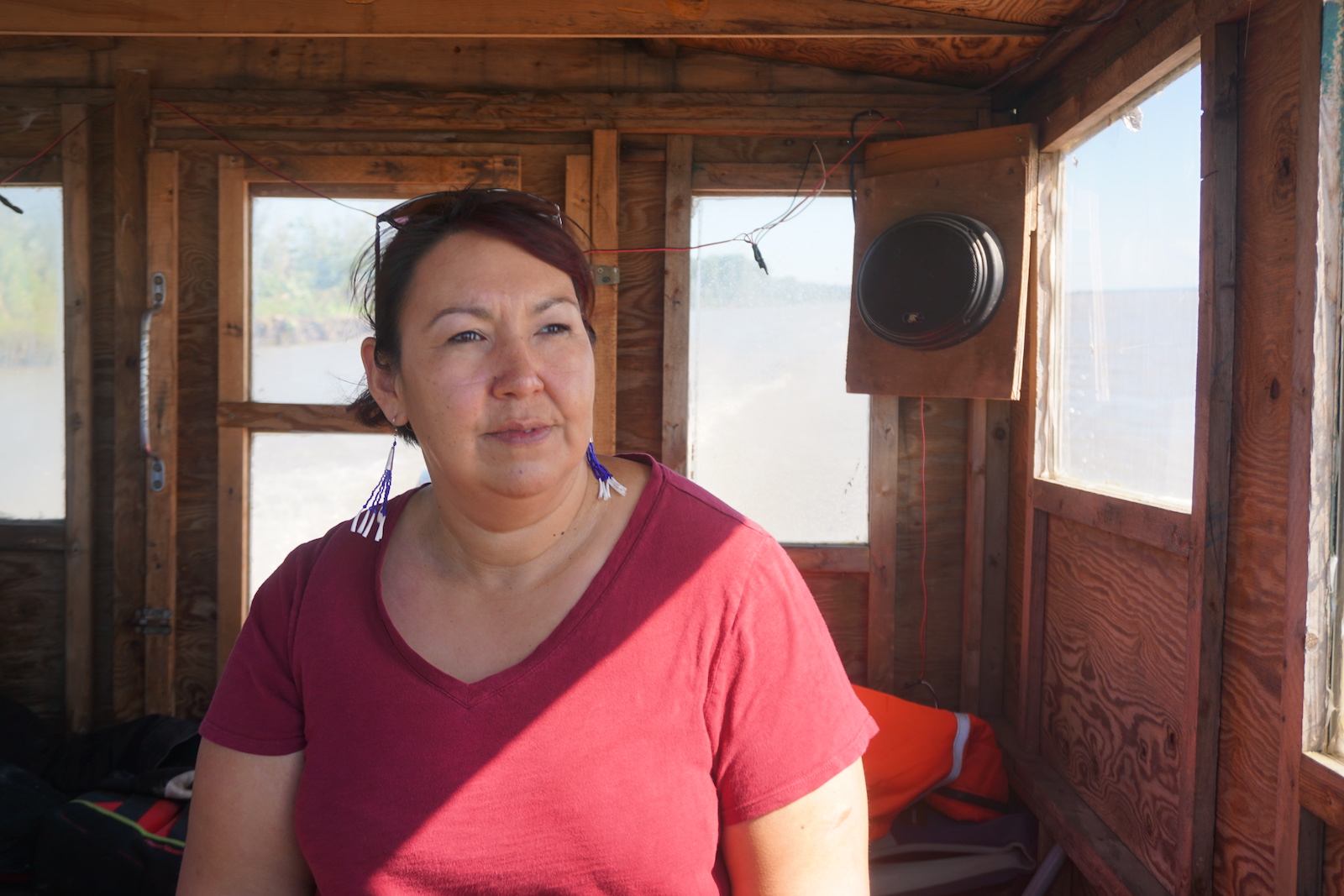
There have been salmon in the Yukon, the fourth-longest river in North America, for as long as there have been people on its banks. The river’s abundance helped Alaska earn its reputation as one of the last refuges for wild salmon, a place where they once came every year by the millions to spawn in pristine rivers and lakes after migrating thousands of miles. But as temperatures in western Alaska and the Bering Sea creep higher, the Yukon’s salmon populations have plunged.
State and federal fishery managers have resorted to drastic measures to save them. In 2021, for the first time in Fitka’s life, regulators prohibited all fishing for the river’s two main salmon species — king and chum — even for subsistence. For the better part of three fishing seasons, thousands of Yup’ik and Athabascan fishers have been banned from catching the fish that once kept their families fed.
“We grew up with fishing, cutting fish, smoking fish all our lives,” Fitka said. “And to have it taken away just like that — without warning, without mentally preparing yourself — is traumatizing.”

All five species of Pacific salmon swim in the Yukon, but Fitka’s family and the thousands of other Indigenous people who live on the river rely mainly on kings and chum. The kings usually arrive at the mouth of the Yukon in early June. With a range that extends from California to Russia’s Far East, they’re the biggest, fattiest, and priciest species, selling for more than $40 a pound at high-end grocery stores in the lower 48 states. Around the same time come the chum, a less fatty, more abundant cousin of the king.
Staggering numbers of both species have disappeared in recent years. Two decades ago, for instance, more than 200,000 kings would make it back to the Yukon to spawn each year. This summer, scientists counted just 58,500, which was slightly better than the previous summer’s meager tally, the worst on record.
The Yukon’s chum swim up the river in two distinct runs, a summer run that starts in early June and a “fall” one that starts in late July. Although the summer run showed signs of a rebound (the nearly 850,000 chum allowed for a brief window of fishing), the fall run comprised only 290,000 chum, less than one-third its historical average.
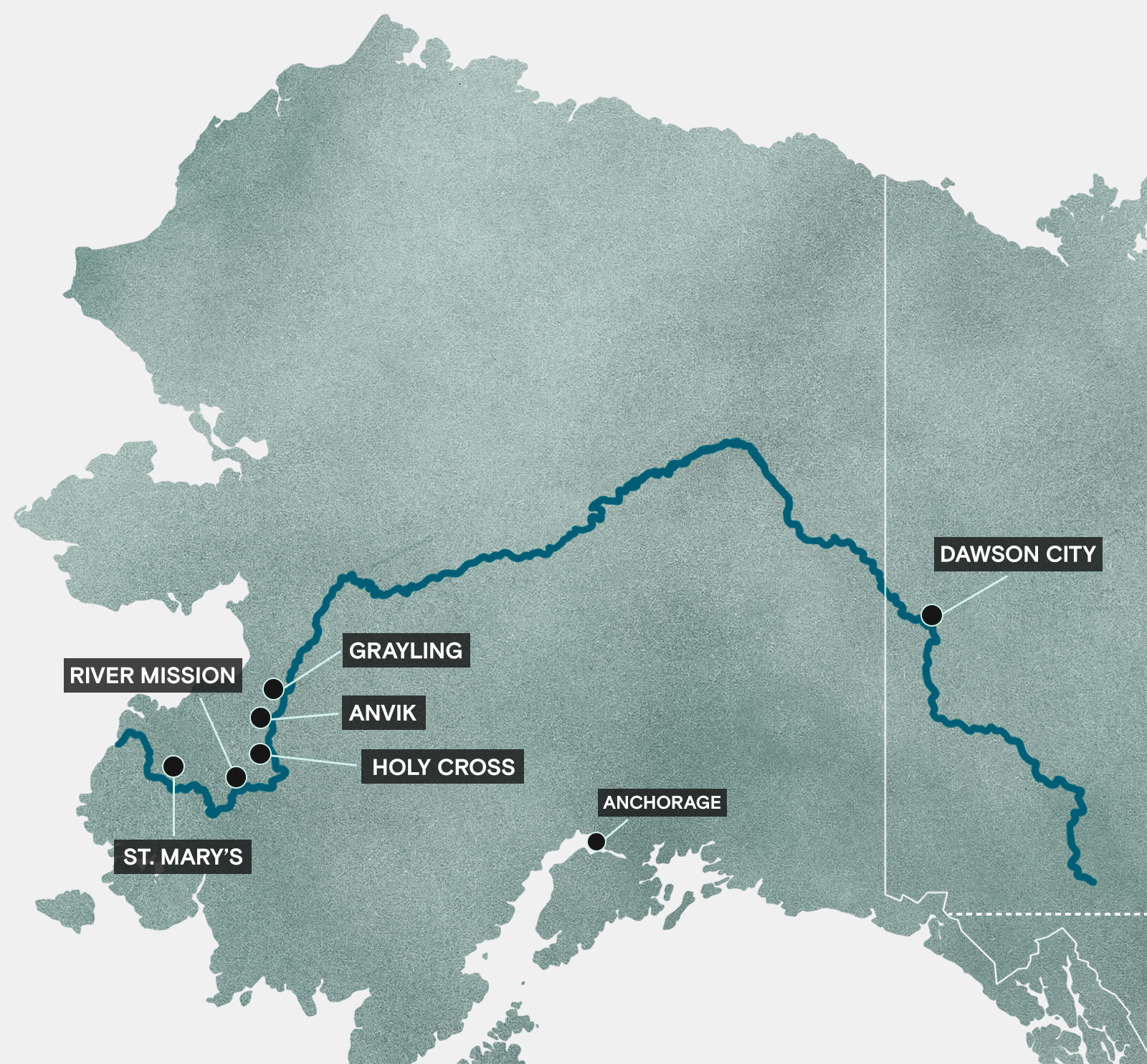
Salmon are vital to the river’s Yup’ik and Athabascan communities as a source of nutrients and a symbol of cultural identity. Dense with protein and fat, Yukon kings are highly nutritious. To swim as many as 2,000 miles upriver, against the current — the world’s longest salmon migration — the fish put on huge stores of fat, some bulking up to 90 pounds. (Their journey is equal to running an ultramarathon every day for a month without stopping for a snack.)
“There’s nothing richer than a Yukon king,” said David Walker, a longtime fisherman and the water plant manager in the Deg Xit’an Athabascan village of Holy Cross.
Such a nutritious food source is especially important to the people living in one of the most remote regions in the United States: Many villages along the Yukon and its tributaries have no more than a few hundred residents and are accessible only by river boat or small plane. That isolation makes the cost of goods exorbitant and fresh produce scarce. A gallon of gas in the small Holikachuk and Deg Xit’an village of Grayling costs $8. Twenty miles downstream, in the smaller village of Anvik, a tin of spam sells at the only store in town for $7.95.
“Our food and fuel — everything has to be brought in by barge or by airplane — so that really increases the cost of living,” Fitka said. “That’s why we’re so reliant on our fish and our animals that we harvest.” According to a 2017 survey by the Alaska Department of Fish and Game, every household in rural western Alaska makes use of fish, and people in the region eat an average of 379 pounds of wild food each year.

Salmon also embody a custom that has brought relatives and neighbors together for generations. Across more than 1,000 miles, from Yup’ik villages at the mouth of the river to Han and Gwich’in fish camps near the Canadian border, Alaska Native families spend much of their summers at the river’s edge, hauling in fish, carving them into filets or strips, hanging them to dry, smoking, eating, and sharing them.
Fitka’s job is to help protect this tradition. She’s the executive director of the Yukon River Drainage Fisheries Association, a nonprofit that advocates for salmon conservation and subsistence fishing rights along the river. On the boat in July, she was leading an educational exchange with a handful of visitors from the upper Yukon in Canada, where the lack of fish has been devastating for several First Nations.
In Old Crow, a village of 200 people in the Yukon Territory, the town’s sonar station on the Porcupine River, a tributary of the Yukon, counted just 349 king salmon last year, according to Katherine Peter, fisheries and harvest support coordinator for the Vuntut Gwich’in First Nation. So this summer, the Vuntut Gwich’in government shut down all fishing for any species for the first time, in an attempt to help as many salmon get up river to spawning grounds as possible.
As the boat cut through chop on its way to Russian Mission, a Yup’ik village about 100 miles upstream from St. Mary’s, we passed a handful of fish camps tucked away from the bank. The river would usually be abuzz with fishing activity in mid-summer: outboards humming, nets drifting, and smoke billowing from smokehouses dotting the shore. But that July day, we were the only people on the water.

Anglers along the Pacific coast of North America have been staring down steadily diminishing salmon runs since the start of the millennium. In Washington state, overfishing, pollution, and habitat loss have shrunk Puget Sound’s population of king salmon to one-tenth its historic size. California’s rivers, like the Klamath and Sacramento, used to support millions of king and coho salmon. Those stocks have thinned to just a few hundred thousand. The shortages prompted the federal government to shut down California’s king salmon season this year for the third time in 15 years.
On the Yukon, the first real dip in numbers occurred in 1998, when roughly 100,000 fish returned to spawn, about half the size of a normal run. Two years later, the run fell by half again.
The collapse put pressure on governments to conserve stocks. In 2001, the state of Alaska narrowed windows for subsistence fishing from 7 days to 48 hours and took unprecedented steps to restrict commercial fishing, which families on the Yukon depend on for income. The Canadian government restricted the commercial king salmon catch, which all but disappeared.
The closures came at a high cost for the region’s economy. Average earnings for people who fish for a living on the lower river dropped from more than $10,000 in the 1990s to about $2,000 after 2000. In Dawson City, a small outpost on the upper river that was the Yukon Territory’s commercial fishing hub, the salmon industry “washed away,” said Spruce Gerberding, who grew up fishing as part of his family’s business near Dawson.

Since then, the situation has grown more dire. The number of kings crossing into Canada routinely fails to meet the goal of 42,500 agreed upon by U.S. and Canadian officials under the Yukon River Salmon Agreement. (That treaty, finalized in 2002, aimed to make sure enough salmon would reach their spawning grounds in the Yukon Territory and British Columbia each year.)
The collapse of the Yukon’s chum was more sudden. Runs regularly numbered in the millions until 2020. That year, anglers and scientists alike were astonished when the usual droves of chum failed to appear. A year later, both the summer and fall runs had dropped to their lowest levels on record — each below 500,000.
The disappearance of so many chums and kings has been the subject of growing scientific inquiry. For years, the vanishing kings posed an ecological mystery because the Yukon flows mostly unimpeded — untouched by the sort of industrialization that has destroyed salmon habitat in California, Oregon, and Washington. The river’s salmon don’t have to contend with large-scale dams that block passage to spawning grounds, clear-cuts that destroy streams, or mega-farms that siphon off water.
But salmon are notoriously difficult to study. They spawn in fresh water, then spend most of their lives far out in the Pacific, an area dubbed the “black box” because it’s so vast and poorly understood. Most salmon research — in Alaska and along the entire Pacific Coast — is focused on streams and lakes, where it’s easier to study their habitat, sample the water, and count stocks.
Scientists have recently made progress in unraveling the mystery in the Yukon, and their main suspect is climate change. As humans pump greenhouse gases into the air and cause global temperatures to rise, salmon are getting hit on two fronts: Both their saltwater feeding habitat and their freshwater spawning grounds are rapidly heating up. Marine heat waves in the Bering Sea and the Gulf of Alaska are becoming more frequent, and the Yukon itself, like other northern rivers, is warming twice as fast as streams farther south.
“Salmon are cold-water species, so when temperatures go up, their metabolism increases, so they need more energy to just be, just live,” said Ed Farley, an ecologist at the National Oceanic and Atmospheric Administration’s Alaska Fisheries Science Center. “That means they’re going to have to feed more.”
At the same time, hot spells in the ocean and melting sea ice have set off a cascade of changes, forcing salmon to find new food. When the Bering Sea heats up, juvenile chum don’t nab as much of their usual, nutrient-dense prey, like krill, tunicates, and small fish. Instead, they settle for jellyfish, which proliferate in warm seas and carry less fat. Salmon wind up burning more energy while consuming fewer calories, and struggling to pack on the fat necessary to survive in the open ocean and, later, complete their long journey up the Yukon.
During recent marine heat waves, scientists found chum with empty stomachs and smaller fat reserves — “by far the lowest we have ever seen in the 20 years of monitoring salmon in the northern Bering Sea,” said Katie Howard, who leads Yukon River salmon research at the Alaska Department of Fish and Game.
“The chum, pretty much as soon as they hatch, they migrate out of the river,” Howard said. “They’re tiny, tiny, tiny fish. They’re probably less prepared to deal with this big change, with higher temperatures and different food available.”
It’s more complicated for kings. Juveniles spend more time maturing in fresh water than chum. That extra year lets them fatten up before they head out to sea, giving them more energy and a better chance at survival in the warming ocean, Howard said.
Still, even though kings aren’t dying at sea in the same way that chum are, they are returning to the river younger, smaller, and increasingly malnourished. That makes them susceptible to rising river temperatures, which force the fish to burn through fat reserves more quickly.
They are also dealing with a new disease that appears linked to rising temperatures. A parasitic protozoa called Ichthyophonus, which is harmless to humans but eats away at fish tissue, has been showing up in more and more salmon, their hearts speckled with white bumps. Scientists aren’t sure exactly what’s causing the spike in infections. What they do know, according to Howard, is that the onset and severity of the disease seems to increase in warm waters.
Compared to other king salmon populations struggling with climate change, lack of nutrients, and disease, those in the Yukon are doing especially poorly. Howard has an idea about why: They’re the farthest north, and they migrate the farthest in fresh water.
In rivers to the south, Howard said, some fish populations have shifted their migrations earlier in the season when the water is cooler. That’s not an option for Yukon kings because they’re so far north that the summer season isn’t long enough to accommodate such a move. They can’t swim under the ice that covers the river into May, Howard said.
“They’re going to be the first ones to struggle,” Howard said, “because they are already at the extreme of what salmon can do.”

When salmon from the Yukon River feed in the Bering Sea and the Gulf of Alaska, they need to navigate more than unusually warm waters. Some end up in the nets of commercial fishing boats, hundreds of miles from villages on the river. Massive trawlers in the Bering Sea accidentally scoop up salmon while targeting pollock and other species. Smaller vessels farther south, in a commercial zone off the Alaska Peninsula called Area M, catch and sell salmon, including chum and some kings from the Yukon. Much of the chum intentionally caught at sea gets frozen, sent to processors in China and elsewhere in Asia, then packaged and sold in chunks at grocery stores in the U.S. and Europe.
Many people on the Yukon feel angered by this double standard. Why do federal and state regulators prevent them from fishing, both commercially and for food, but allow big businesses to catch salmon in the ocean — sometimes incidentally, sometimes for profit?
“I don’t know why they shut us down. We’re not the problem,” said Ronald Demientieff, an elder in Holy Cross. “You have to regulate us because they killed them in the ocean? We’ve been regulating our fish way before Fish and Game came to this place.”
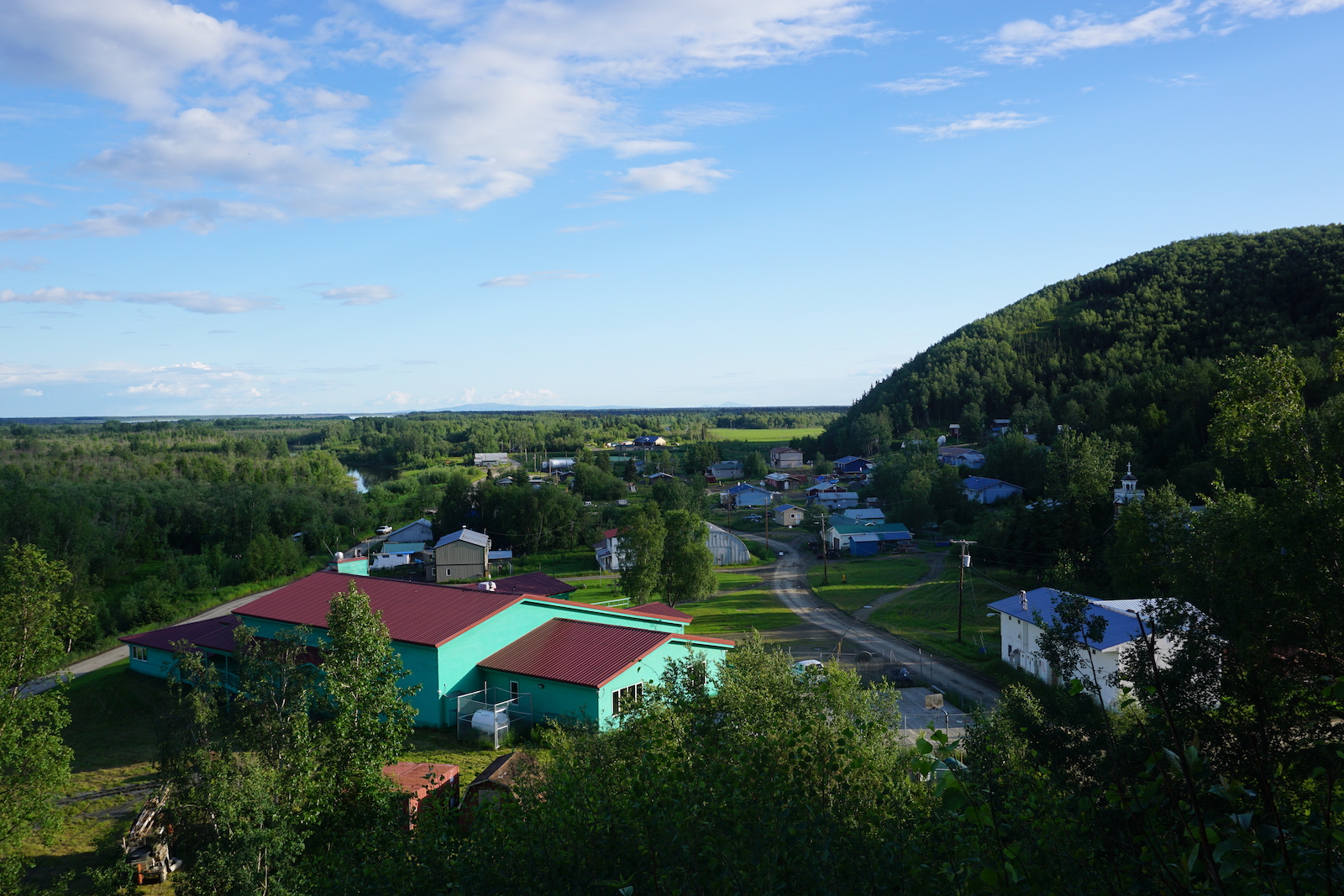
The trawlers, which make up the biggest fishery by volume in the U.S., deploy gigantic, billowing nets that sometimes scrape across the bottom of the ocean as they wrangle pollock — the meat used in McDonald’s Filet-O-Fish. Their nets can span the length of four football fields, large enough to capture hundreds of thousands of salmon as bycatch over the course of a season, including Yukon kings and chum.
Scientists are quick to say that these fisheries can’t be blamed for the Yukon’s salmon declines. The math just doesn’t check out. According to the National Oceanic and Atmospheric Administration, or NOAA, trawlers in the Bering Sea catch about 20,000 king salmon each year, and roughly half of those come from western Alaska. In 2021, about 50,000 chum from western Alaska and the Yukon wound up in the pollock nets, a number that’s well short of the 1.5 million that disappeared that year.
“If you look at how many fish they’re catching [that are heading] to western Alaska, it cannot explain anywhere near the decline in the chum salmon that just occurred,” Farley said. “It’s a small number of fish from western Alaska being caught in the bycatch.”
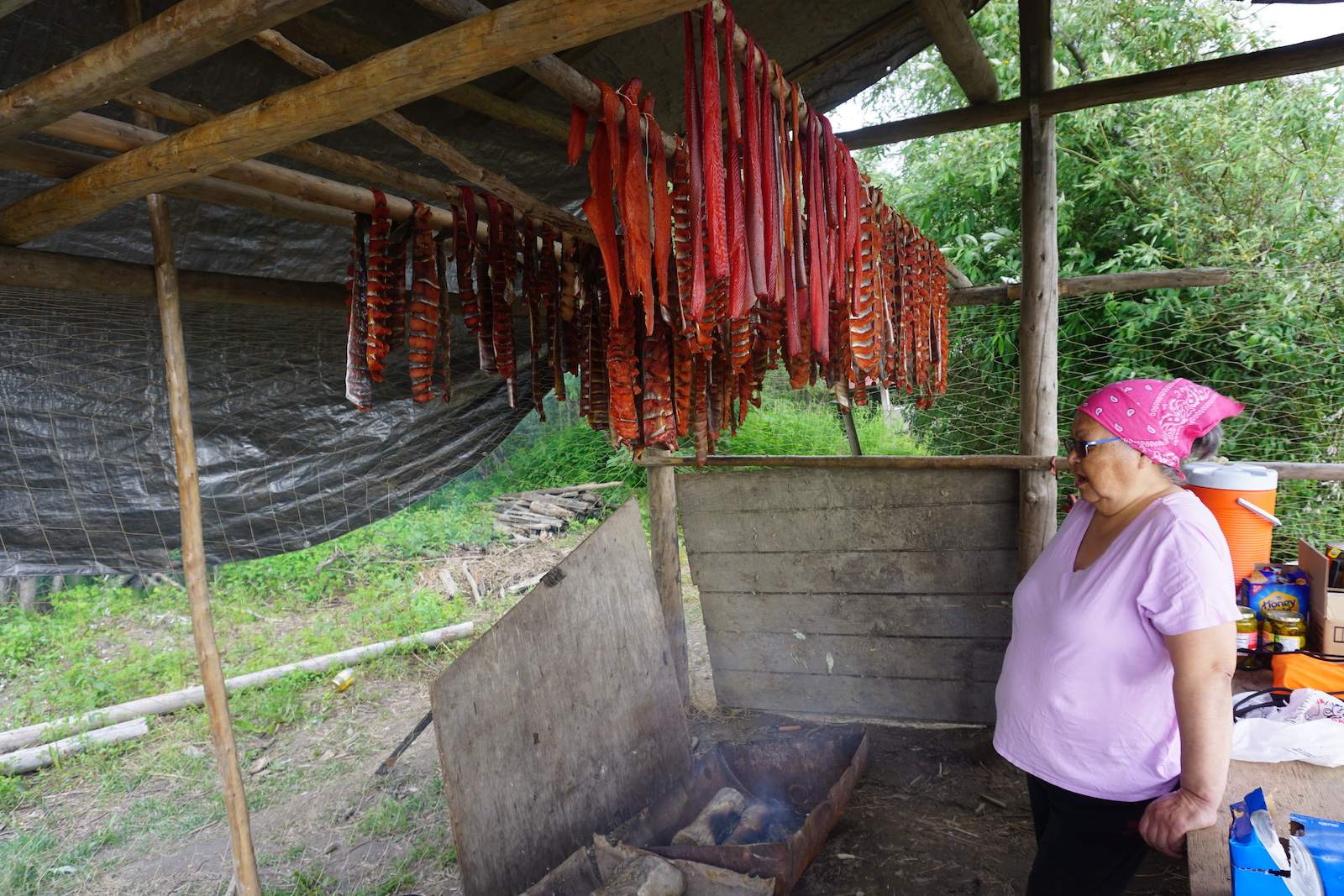
Even though bycatch doesn’t appear to be a major driver of the salmon shortage, Yukon salmon are still swimming into large nets at sea at the same time that communities along the river are being told to keep their nets out of the water. In 2021, when Alaska Native families on the Yukon weren’t allowed to fish for chum or kings, Bering Sea trawlers incidentally scooped up more than 18,000 western Alaska kings and 51,500 chums. Not all of those were from the Yukon, but some were, and others were from stocks on rivers like the Kuskokwim, where there have also been severe shortages and fishing bans in recent years.
“Whether it’s 1 percent or 0.25 percent — or whatever percent [of bycatch] they’re trying to say that reaches the Yukon — that is a percentage that we need,” Fitka said. “We need it in the river if we want to rebuild our stocks.”
In Area M, fishing businesses had a banner season in June 2021, hauling in more than 1.1 million chums. State biologists aren’t sure exactly how many of those were headed back to the Yukon, though it was likely a small fraction. Researchers estimated a year later that the Area M fleet caught about 5 percent of the chums bound for western Alaska, while people along the river weren’t allowed to catch a single fish to eat.
Unlike Indigenous nations in other places such as Washington state, Alaska Native communities on the Yukon don’t have treaty rights to fish. Under state and federal law, subsistence fishing in Alaska is given priority over other uses like commercial fishing, but Alaska Natives aren’t given priority over other groups. The lack of specific rights — and the lack of control over management decisions — has left tribal leaders with little recourse except to push state and federal officials to adopt stricter conservation measures on fishing companies at sea. That requires navigating a maze of agencies and regulators: The Alaska Board of Fisheries and the Alaska Department of Fish and Game regulate salmon fishing in Area M; those two along with the Federal Subsistence Board and the U.S. Fish and Wildlife Service have jurisdiction over the Yukon River; and the federal North Pacific Fishery Management Council and NOAA Fisheries oversee pollock fishing in the Bering Sea.
Two Indigenous organizations — Tanana Chiefs Conference and the Association of Village Council Presidents — are suing the federal government over its management of the Bering Sea pollock industry, including the amount of bycatch that’s allowed. A federal rule already exists that limits the pollock fleet’s incidental catch of king salmon, but there’s no cap on chum. In October, the North Pacific Fishery Management Council met and agreed to weigh options to reduce chum bycatch, including a limit on fish specifically from western Alaska.
John Linderman, an Alaska Department of Fish and Game official and co-chair of the Yukon River Panel, the joint U.S.-Canada board that governs the Yukon River Salmon Agreement, told Grist that the ideal scenario would be getting bycatch down to zero. Trying to reduce it is an “obligation,” he said. “There are no ifs, ands, or buts.”
Linderman defended the North Pacific Fishery Management Council for taking measures in past years to keep kings out of pollock nets and for looking at new steps to save chums. But no option now being weighed by the council would eliminate bycatch, as some people on the Yukon want.
At the October council meeting, Jon Kurland, NOAA Fisheries’ regional administrator in Alaska and a council member, said an action that would end bycatch “of course would be best for chum salmon, but to me would not be practicable.” Proponents of the pollock industry say a hard cap on chum bycatch could force the lucrative fishery to close. And if that happens, big businesses like American Seafoods wouldn’t be the only to suffer. Kurland noted that many coastal Alaska villages, including several on the lower Yukon, rely on sales generated by the trawlers. (That fact has caused some tension in western Alaska between subsistence fishing advocates and regional nonprofits that bring in revenue from the pollock catch.)
In February, Fitka and dozens of Indigenous leaders from the Yukon and western Alaska traveled to Anchorage for a meeting of the Alaska Board of Fisheries, a group of seven people appointed by the governor to regulate the state’s fisheries, including Area M. They wanted the board to adopt tighter rules on those salmon businesses, asking them to restrict fishing time in June by around 70 percent, a reduction of more than 250 hours.
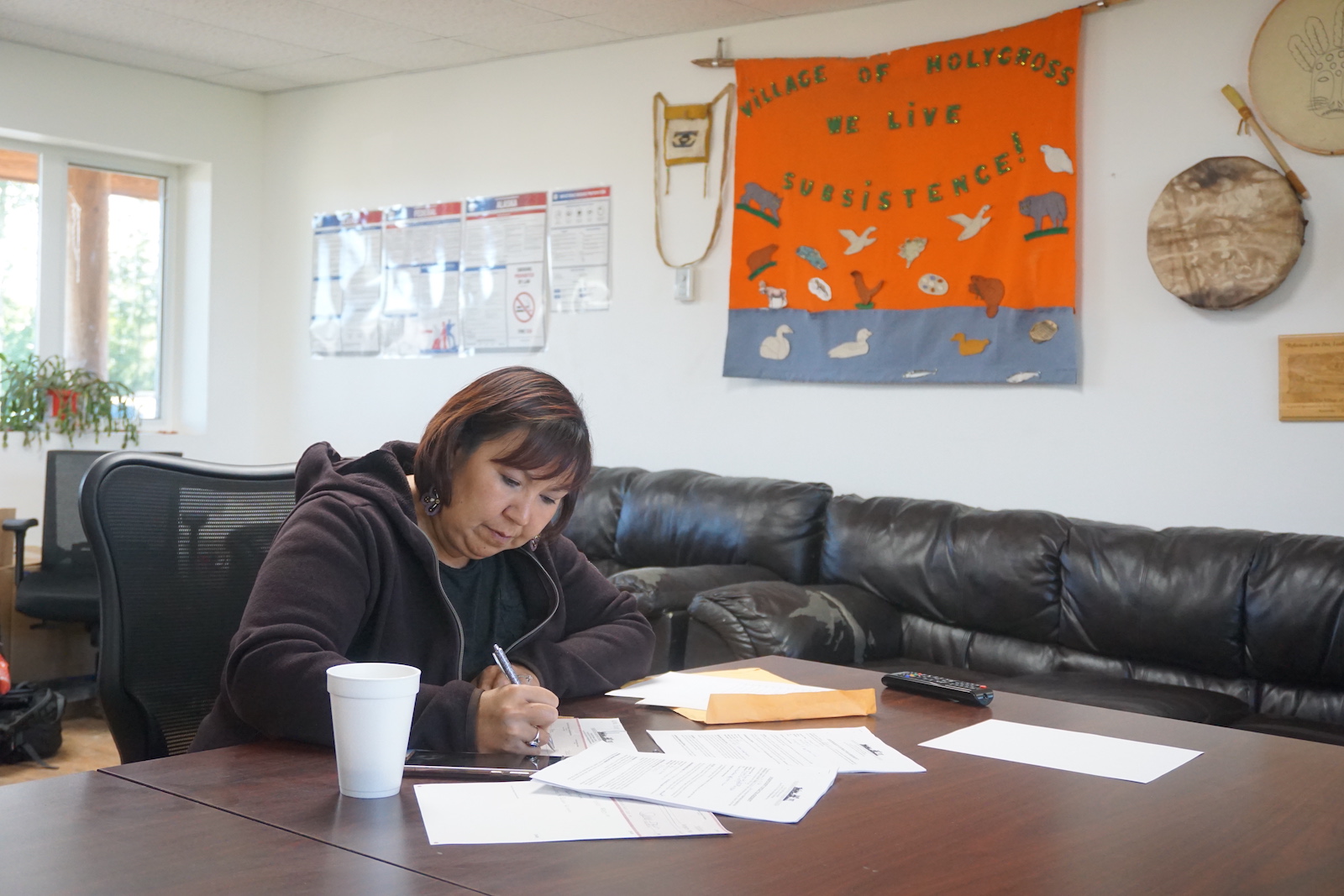
The issue was contentious because commercial fishing advocates and representatives from Alaska Native villages on the Alaska Peninsula and Aleutian Islands, where local economies are linked to the Area M fisheries, largely opposed major restrictions. They said significant cuts would risk sinking Area M fisheries and jeopardize local tax revenue that funds schools and other essential services. After three days of public testimony and several more days of deliberation, the Board of Fisheries narrowly rejected the proposal backed by Yukon tribes and adopted a watered-down version instead, winnowing harvest times by only 42 hours.
After the final vote, Fitka and dozens of other people in her delegation silently walked out of the meeting in protest.

With fish racks and freezers empty along the Yukon river, people are turning to other sources for food. The Yukon’s only commercial fish processor, which has been shut down for three years, started building greenhouses and selling vegetables in 2021. More than a dozen tribal members and elders told Grist that they’re eating more moose, whitefish, pike, and goods bought at village stores, like “chicken, hot dogs, and spam,” according to Walker. And they all seemed to agree on one thing: There’s just no substitute for Yukon salmon.
“Nothing can replace the fish,” said Tessiana Paul, an administrator at the tribal government in Holy Cross. “Gosh, it just feels like we took it for granted now.”
To make up for the shortage in Holy Cross and several villages upriver, the region’s tribal consortium – Tanana Chiefs Conference – sent residents frozen sockeye salmon, a leaner species. The fish came from Bristol Bay, the world’s largest sockeye run, a few hundred miles south of the mouth of the Yukon. In one of the many paradoxes of climate change, Bristol Bay’s sockeye runs have boomed in recent years, as the northern lakes where the fish spawn have warmed to an optimal temperature.
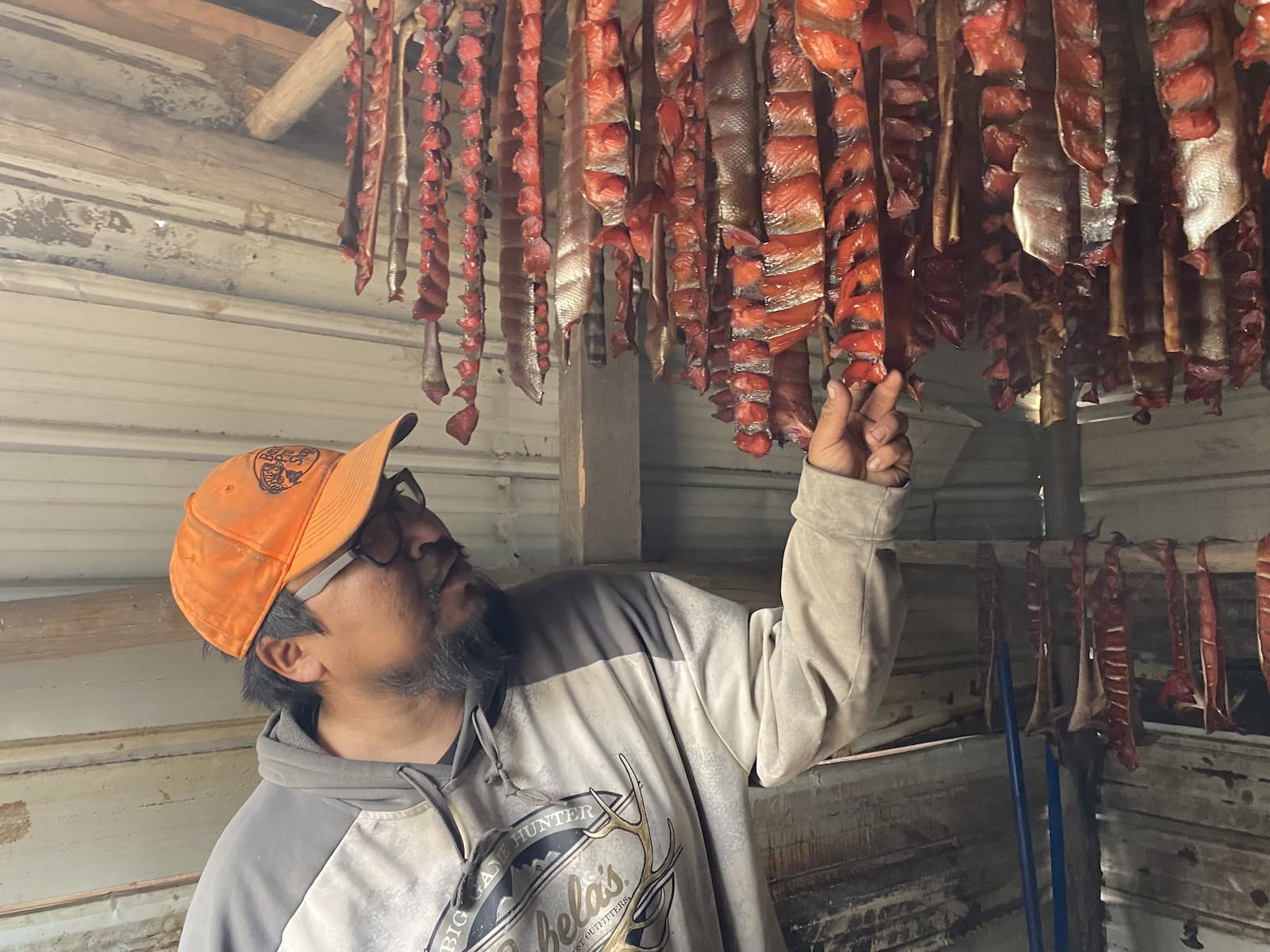
For people who grew up eating fatty Yukon kings and chum, the smaller Bristol Bay salmon, which make a shorter migration and carry less fat, are a disappointing substitute. The first batch of sockeye that came to Holy Cross last fall was decent, according to Walker, though a second bunch that came in late spring was “all freezer-burned.”
“Nobody could eat them. They were as yellow as your paper,” he added, referring to a reporter’s lemon-colored legal pad.
Walker was preparing a stew of moose meat and vegetables, which sat quietly simmering on his stove as he described the need to harvest two moose each year instead of just one, which used to be enough to keep a family fed for months. Without fresh salmon, people are feeling more pressure to hunt.
“A lot of families here — they run out of moose pretty fast,” Walker said. “In fact, somebody was asking us for moose just the other day. I’ve got to give them some.”
For some, the question of what to eat has morphed into a question of whether to leave. In Anvik, a village of some 75 people upstream from Holy Cross, more than a dozen people have moved out in the past few years, according to Robert Walker, the Anvik Tribal Council’s first chief (and David’s cousin). “Right after the fisheries closed down people moved to Anchorage to get jobs,” he said. “The impact was so great they had to find another way of life.”
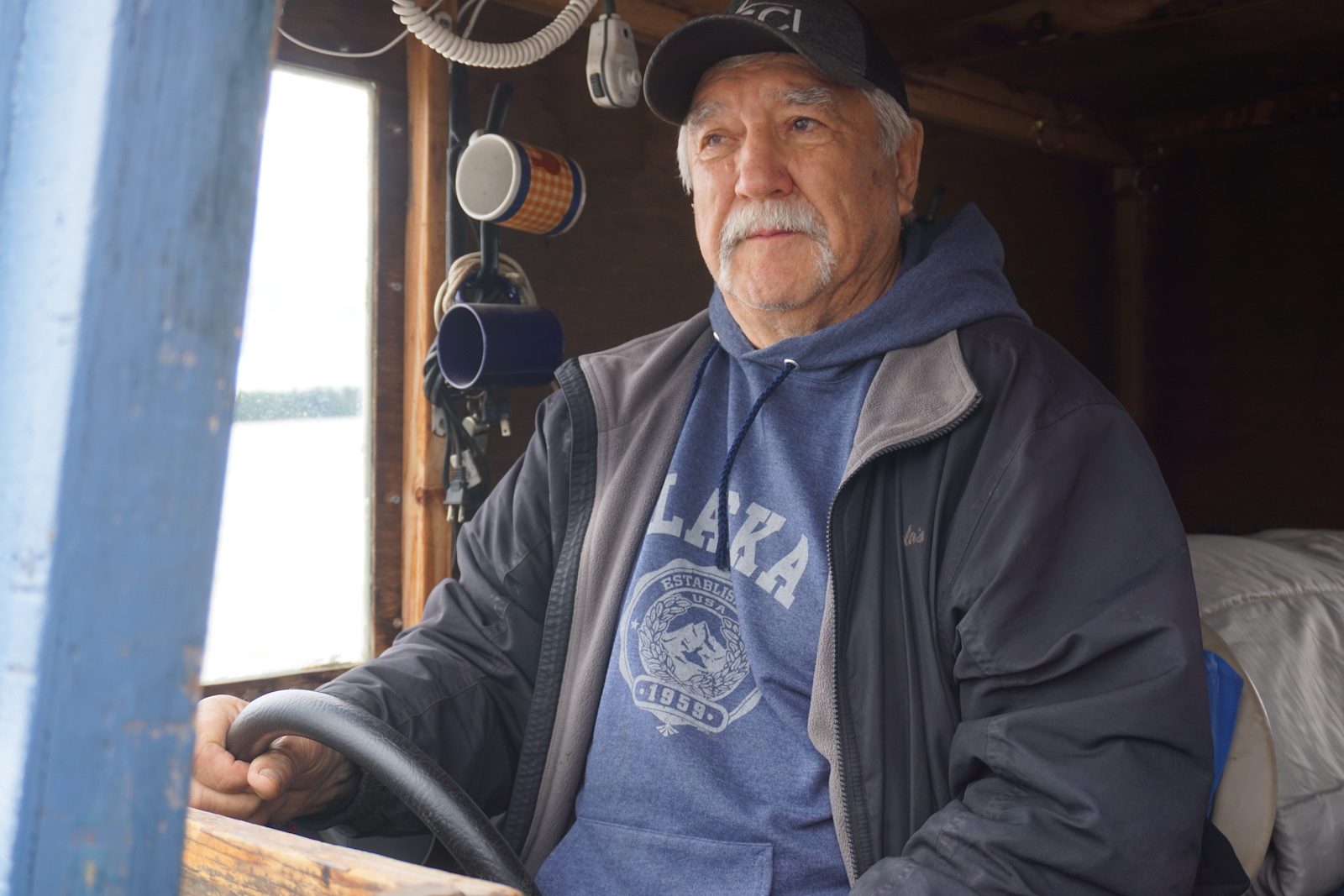
Paul said she and her husband, Eugene, have contemplated leaving Holy Cross, where they both grew up, and are now raising their children. She has the Kenai River in mind, about 300 miles east of Holy Cross and a few hours by car from Anchorage, where visitors and locals alike flock with fly rods or dip nets to scoop salmon out of the water every summer.
“People from Anchorage can easily go down to Kenai and get 40 fish and take them home and put it in their makeshift cache,” Paul said from her office in Holy Cross. So many people line the Kenai’s banks each summer to pluck fish from the river that it’s notorious for so-called “combat fishing,” referring to the anglers jostling for space. “They’re getting more fish than we are on the Kenai, and it’s combat fishing.”
The lack of salmon has been felt around the Kenai, too. Locals once made a living setting nets for kings along the peninsula’s gravel beaches, until their population started falling. This year the state adopted its strictest regulations yet to protect Kenai kings, a move that forced small family businesses to shut down.
Still, to Paul, the thought of having some salmon on the Kenai Peninsula is better than having none in her home village. “It’s probably easier than being here and not being able to fish at all.”

In Russian Mission, the last stop on Fitka’s trip, we finally saw signs of fresh salmon. Slender red fish bellies dripping with oil were slung across wooden drying racks. Boats were nosed up to the beach, sporting fishing nets in their bows. The smell of “summertime perfume” hung in the air: smoldering birch, cottonwood, or alder logs smoking salmon.
Chum numbers had edged back up this summer, and for the first time in three years, the state opened some subsistence fishing for chum on the lower Yukon. The window applied only to the first chum run, and people weren’t allowed to use their preferred gillnets, forced instead to haul in fewer fish using more selective gear like dip nets. Even so, it was welcome news to Basil Larson, who had repaired his camp just in time, after it had been destroyed by a spring flood. By the time we met him, Larson, who is on the board of the Yukon River Drainage Fisheries Association, had already caught two dozen summer chum. He and his mother had carved the fish into long orange strips, and dozens of them hung like streamers in his small smokehouse, about 100 yards from the river. A broad-shouldered man with a long, black goatee, Larson described his internal conflict about catching salmon when there are so few to be found.
“My mind is saying we’ve got to get these fish passing [to spawn],” he said, “but my heart is saying we need a little taste for winter.”
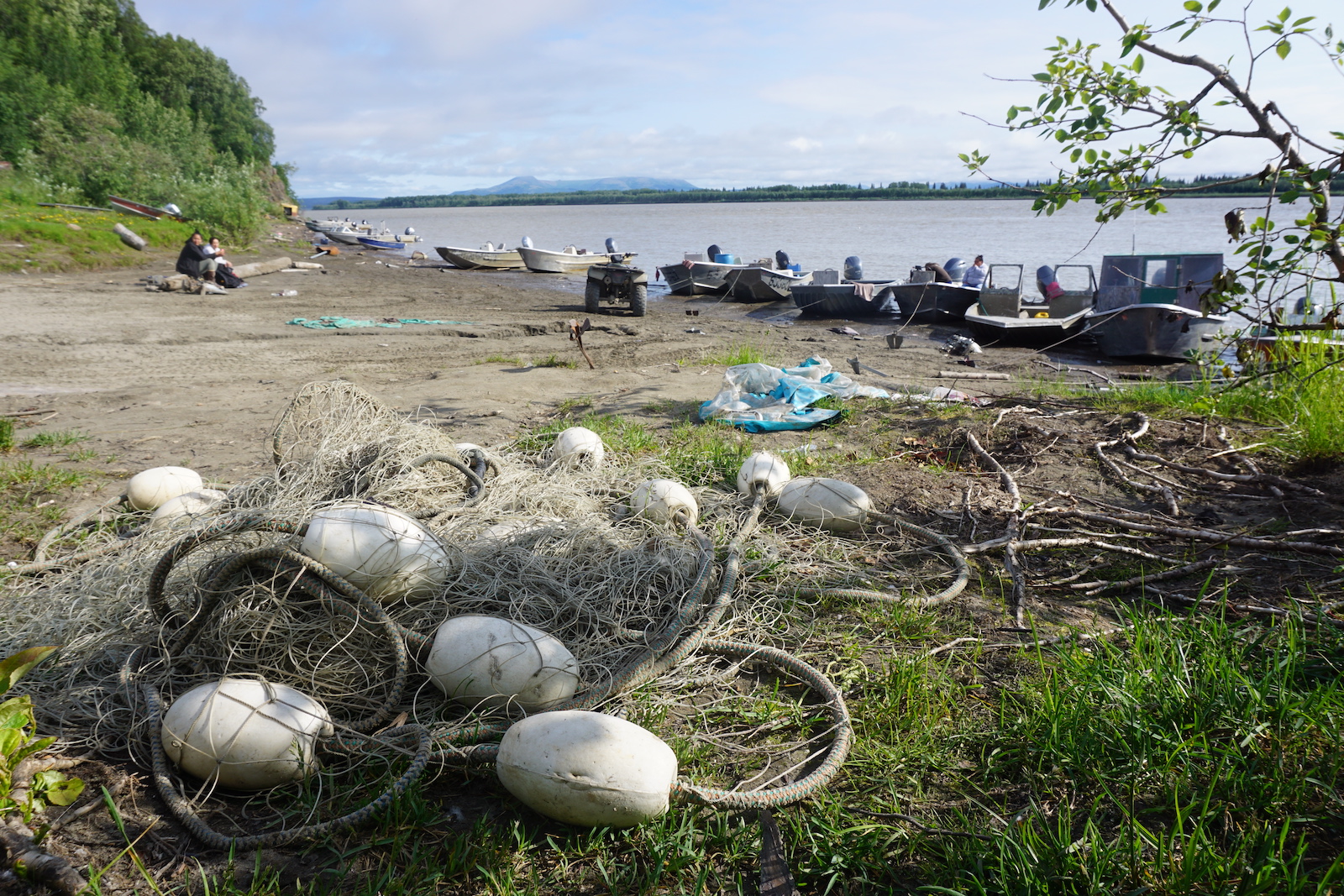
The evening before Larson showed me his fish camp, he and more than 50 other people, including Fitka and the visitors from Canada, got a taste of salmon at a potluck in Russian Mission. In a fluorescently-lit room in the middle of the village, elders shared memories of a time when there were no restrictions on fishing for food. “Everywhere you went, it was always fish oil and fish smoke,” said Charlene Duny, a resident of Russian Mission. “And now when we finally smell it, oh, my mouth waters and my heart aches.”
On a buffet table in the middle of the windowless room lay two small dishes of local salmon, dwarfed by platters of hot dogs and hamburgers. One held a pile of chum strips, each dried into a crimson jerky; the other contained a few dozen half-dried chum bellies, each cut into a pink piece a few inches long. As residents and visitors shuffled through the food line, both dishes slowly emptied. The salmon was gone long before the burgers.
